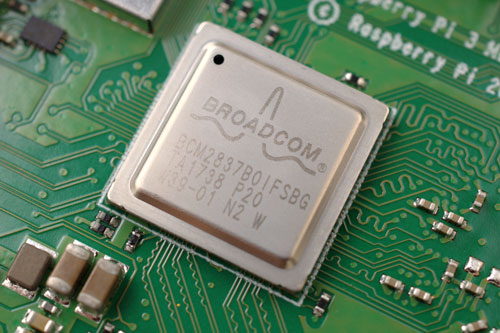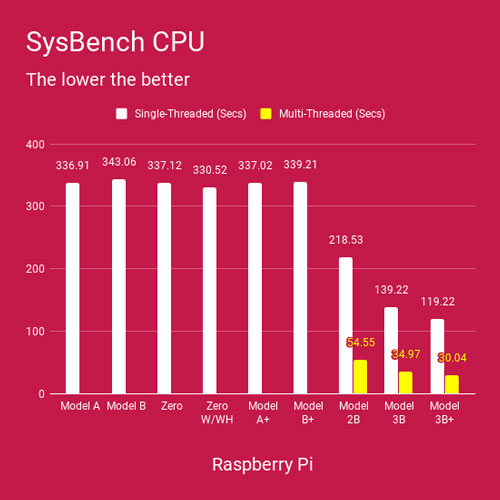With an upgraded processor boasting impressive new packaging and improved networking capabilities, the new Raspberry Pi 3B+ sits head and shoulders above its predecessor the Raspberry Pi 3.
So let's take a look at some of the new features on the latest member of the Raspberry Pi Family.
Raspberry Pi 3B+ specifications
- SoC: Broadcom BCM2837B0 quad-core A53 (ARMv8) 64-bit @ 1.4GHz
- GPU: Broadcom Videocore-IV
- RAM: 1GB LPDDR2 SDRAM
- Networking: Gigabit Ethernet (via USB channel), 2.4GHz and 5GHz 802.11b/g/n/ac Wi-Fi
- Bluetooth: Bluetooth 4.2, Bluetooth Low Energy (BLE)
- Storage: Micro-SD
- GPIO: 40-pin GPIO header, populated
- Ports: HDMI, 3.5mm analogue audio-video jack, 4x USB 2.0, Ethernet, Camera Serial Interface (CSI), Display Serial Interface (DSI)
- Dimensions: 82mm x 56mm x 19.5mm, 50g
Compare this to the Raspberry Pi 3 benchmarks
Faster 1.4GHz CPU
Although it’s the same underlying design as its predecessor, the new Raspberry Pi 3B+’s BCM2837 system-on-chip (SoC) features improved packaging alongside a heat-spreader which have helped boost its performance from 1.2GHz to 1.4GHz.
Faster Ethernet (Gigabit via USB)
The new USB Ethernet controller offers gigabit connectivity at a theoretical maximum throughput of 300Mb/s, due to its use of a single USB channel.
Dual-band 2.4GHz and 5GHz wireless LAN
And a switch to a new dual-band radio module and antenna design inspired by the Pi Zero W improves the Pi 3 B+’s connectivity compared to its predecessor.
You'll need to upgrade Raspbian to the latest version to use the new wireless LAN chip. You can download the latest image file from the Raspberry Pi Downloads page, or open connect via Ethernet, open Terminal and enter the following:
sudo apt-get update
sudo apt-get dist-upgrade
Power over Ethernet (PoE) ready
An optional Power-over-Ethernet (PoE) HAT module, available separately, can power the Pi 3 B+.
Power management
Finally, a clever power management integrated circuit (PMIC) replaces discrete components and provides smoother power.
Benchmarking the Raspberry Pi Pi 3
The promise of improved performance is one thing, but there’s only one way to get to the truth of the matter: benchmark testing.
Python GPIO
Driving the GPIO pins via Python can result in a CPU bottleneck, as demonstrated by this simplest of programs: a pin is switched on and off as quickly as possible while connected to a frequency counter. Note that updates to the GPIO driver and Python itself will alter these results.
SysBench CPU
A synthetic benchmark designed to stress the central processor, SysBench’s CPU test highlights the performance gains available to CPU-bound applications - in particular those which can take advantage of the multiple processing cores available on the Pi 2, Pi 3, and Pi 3 B+.
SysBench Memory Throughput
Not all applications are limited by available CPU performance, with some reliant on memory throughput - the speed at which data can be written to and read from RAM. The SysBench memory test carries out repeated 1KB reads and writes then reports the throughput in megabytes per second (MB/s).
- Higher is better, sysbench --test=memory --memory-block-size=1K --memory-total-size=10G --memory-oper=write run
- Higher is better, sysbench --test=memory --memory-block-size=1K --memory-total-size=10G --memory-oper=read run
Ethernet Throughput
The Ethernet port, which connects via a shared USB channel, has been the last feature of the Raspberry Pi design to receive an upgrade. This test copies an incompressible 100MB file to each Pi on test, and there’s no surprise in seeing the Pi 3 B+’s gigabit Ethernet topping the chart.
Power Draw
More performance is always welcome, but there’s no such thing as a free lunch. This test, which measures power draw at the desktop with an HDMI display, wireless keyboard, and - where applicable - Ethernet connected, shows how an older model of Pi may be better suited to battery-powered and embedded applications.

















